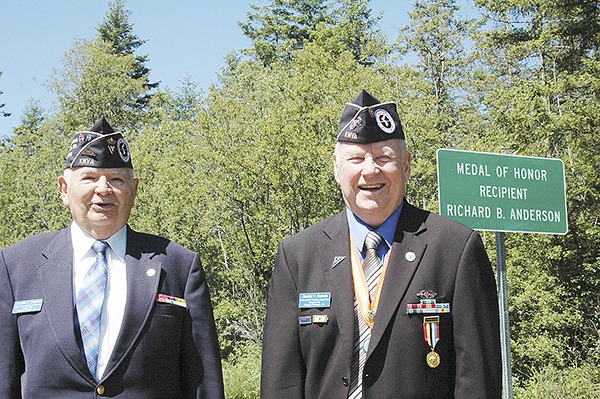More than seven decades after his death in the service of his country, Private First Class Richard Beatty Anderson has another high honor for his sacrifice.
A four-mile stretch of U.S. Highway 101 is now a Medal of Honor Highway, in recognition of Anderson and three other Congressional Medal of Honor recipients, after gaining approval from state legislators in April.
The legislation, sponsored by Sen. Jim Hargrove (D-Hoquiam), honors each veteran with his own mile near the Clallam-Jefferson county line.
“Honoring the sacrifice these men made for their country is one small way of saying thank you,” Hargrove said. “This stretch of highway will help our community remember the service of these courageous Americans.”
Olympic Peninsula resident Gerald Rettela has helped spearhead the effort to see the highway gets the designation.
“After serving in the military, I knew that it was so important to recognize those who have sacrificed,” he said.
Rettela, who served in the Korean War as a staff sergeant from 1953-1956, has been an advocate for veterans of all branches of the U.S. armed services before his move to Washington in 2004. He led efforts to establish the Korean War Memorial Highway (state Highways 113 and 112) in 2008, the Vietnam Memorial Highway (state Highway 112) in 2009 and the Desert Storm/Desert Shield Memorial Highway (state Highway 110) in 2010.
“I ran (the idea) across to Sen. Hargrove; he thought it was a good idea,” Rettela said.
Rettela said the original idea was to name Highway 19 — one that connects Highways 104 and 20 in Jefferson County — after the Medal of Honor recipients. As it turned out, Dick Bennett, husband of Marvin Shields’ widow Joan Shields Bennett, was leading an effort to have part of Highway 101 named in honor of Shields. Not long after Rettela gave Jefferson County commissioners a proposal for the Highway 19 honor, the two met and changed courses slightly.
Now, family and friends can find recognition of those four veterans on Highway 101 — not a common honor, Rettela said.
“Very rarely can you put (something like this) on a federal highway,” he said. “They wanted to have it on (Highway) 101 because it would have more exposure. The recognition is quite extraordinary.”
Courageous acts
In 1944, Anderson — an Agnew and Clallam County resident and a mortar man in the 2nd Battalion, 23rd Infantry Regiment, 4th Marine Division of the United States Marine Corps — received the Medal of Honor for saving three men by tucking a live grenade into his midsection before it exploded on the island of Roi Namur in the Marshall Islands.
Others honored by the highway designation include:
• Cpl. Francis A. Bishop, a Port Angeles and Clallam County resident and a member of Charlie Company, 57th Pennsylvania Volunteer Infantry in the Union Army, who received the Medal of Honor for capturing the Confederate flag in the Battle of Spotsylvania in 1864;
• In 1865, Cpl. Thaddeus S. Smith, a Port Townsend and Jefferson County resident and a member of Easy Company, 6th Pennsylvania Reserve in the Union Army, who received the Medal of Honor for flushing out a Confederate sharpshooter nest at the Battle of Gettysburg in 1865, and
• Construction Mechanic Third Class Marvin Glenn Shields, a Port Townsend and Jefferson County resident and a Seabee of the United States Navy, who received the Medal of Honor by saving the lives of United States Army Special Forces personnel at a compound in Đong Xoài, ultimately being wounded three times and fatally by North Vietnamese forces in June of 1965.
An Agnew native
Anderson was born in Tacoma on June 26, 1921, and was raised in Agnew. He attended Macleay School in Agnew before graduating from Sequim High School. He then entered the Marine Corps on July 6, 1942, in Oakland, Calif., receiving his recruit training at the Marine Corps Recruit Depot San Diego.
Anderson then joined the Marine Barracks, Naval Receiving Station in San Diego in October 1942. Promoted to private first class on April 12, 1943, he was ordered to the Infantry Battalion Training Center at Camp Elliott in San Diego, shortly afterwards.
He next joined his last unit, Company E, 2nd Battalion, 23rd Marines, and with his unit he left the United States in January 1944. The following month he landed on Roi Island in the Marshall Islands. (Roi Island was the first pre-war Japanese territory to fall to Marines.)
Anderson was hunting enemy snipers. He hurled himself on a live grenade in a shell hole to save the lives of three fellow Marines though he knew death for himself was almost certain. He was evacuated to a ship, where he died of his wounds on Feb. 1, 1944. He is buried at the New Tacoma Cemetery in Tacoma.
He posthumously received the Medal of Honor — the nation’s highest military decoration — and the Purple Heart.
In 1945, the United States Navy destroyer USS Richard B. Anderson (DD-786) was named in his honor.
On Sept. 2, 2008, the Port Angeles Federal Building was renamed the “Richard B. Anderson Federal Building” in his honor. During the renaming ceremony, a letter written by Harry Pearce was read; Pearce was one of the three men that Anderson had saved.
Shields honored
Friends, family and the community honored CM3 Marvin G. Shields at a special 50th anniversary remembrance ceremony on June 10 at the Gardiner Cemetery.
Among the dignitaries on hand were ‘Alfie’ Alvarado-Ramos, director ofWashington State Department of Veterans Affairs, Read Admiral Kate Gregory, and Captain Mark Geronime, Commanding Officer for Naval Facilities Engineering Command Northwest.



